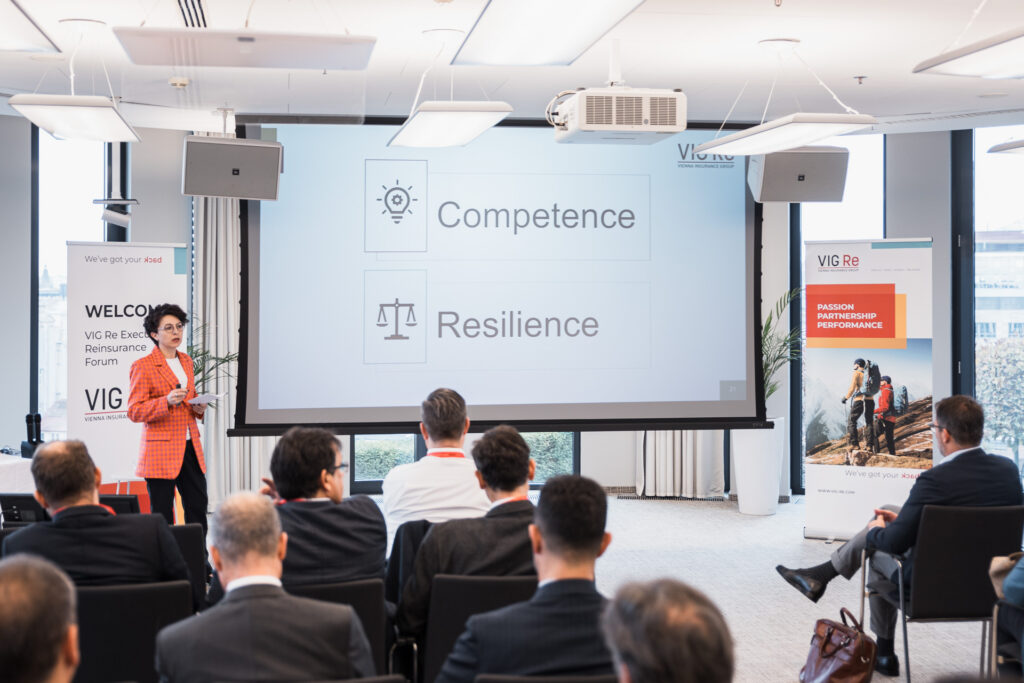Cristina Ferrari is the chief underwriting officer of VIG Re and is responsible for the corporate underwriting department. She oversees a number of crucial elements, including defining the company’s risk appetite, ensuring adherence to underwriting risk standards through processes like referral approval, and maintaining portfolio resilience through diversification and accumulation control.
Additionally, she leads a team of actuaries who develop technical pricing methodologies and tools for the underwriting community, thereby establishing a comprehensive framework for governance and pricing strategies. Insurtech Insights finds out more.
Tell us how and why you decided to pursue a career in insurance
Certainly. My journey into the insurance industry began unexpectedly after my studies in Italy. Initially, I stumbled into a role as a claims’ handler, which later transitioned into a compliance officer position. My educational and legal background seemed to naturally align with these roles, so it felt like a logical progression at the time.
However, my career journey took a significant turn when I decided to pursue a full-time MBA. During this time, I realised the potential for a more targeted career path within the industry, particularly in reinsurance. I saw reinsurance as a fascinating niche within the financial sector and was drawn to the opportunities it presented.
The desire for a focused career path led me to Switzerland, where I joined Swiss Re. It was a deliberate move to immerse myself in an international environment and explore the intricacies of underwriting. Over time, I developed a deep passion for underwriting, which has become the cornerstone of my professional journey.

You switched from Swiss Re after 13 years, to VIG Re just a year ago. What was it about the opportunity at VIG Re that prompted you to move on?
There were a few key dimensions that influenced my decision. Firstly, the opportunity to join a successful yet smaller company, within the industry segment I enjoyed, was very appealing. I was looking for a different experience within a more intimate environment.
Secondly, while data and digitalisation are significant aspects, what moves the needle in life and business are people. The calibre of the management at VIG Re was a major draw for me. I was already familiar with some representatives, who are leading market professionals with strong work ethics, which was a definite plus.
Lastly, the role itself – Chief Underwriting Officer – presented an opportunity to engage with various dimensions of the risk value chain. I’m able to make a tangible impact and see the results of decisions quickly.
So, you’ve enjoyed the challenge of moving from a global company to a smaller entity?
Absolutely, without a doubt. I have fond memories of my time at Swiss Re. They have been an exceptional employer, providing me with numerous exciting opportunities. I’ve been able to stay with the company, feeling valued and consistently intellectually stimulated, all while remaining focused on underwriting. This aspect will always hold a special place in my heart.
However, transitioning to a different organisational setup and relocating to a different country, as VIG Re is headquartered in Prague, offers a fresh perspective. Engaging with a new culture and mindset is incredibly exciting for me. So, I’m genuinely thrilled about this new chapter and the opportunities it brings.
P&C is quite a challenging space at the moment. As a chief underwriting officer, what are the key critical challenges you would say are facing the space in 2024 from your perspective?
I believe the core responsibility of a Chief Underwriting Officer is to ensure the resilience and technical performance of the (re)insurance portfolio, by anticipating and identifying new risks on the horizon.
Currently, we face significant instability and uncertainty due to geopolitical tensions, economic conditions, and the intricate interconnections between risks. This complexity underscores the multidimensional nature of insurance risks today, and will further increase in the future.

The key challenge from an underwriting perspective lies in navigating this environment effectively. It requires maintaining underwriting discipline, rigour in technical assessments, and a forward-looking mindset to anticipate how risks may evolve. Pricing policies must reflect these evolving dynamics.
While the industry has experienced a robust renewal, there are here and there signs of potential relaxation in underwriting standards. Therefore, preserving technical discipline remains a critical challenge for our industry at this point.
What kinds of solutions do you think can be best applied when handling these sorts of challenges?
The complexity of the current situation suggests that there is no straightforward solution, at least not one that I’ve discovered yet, and certainly no “one size fits all”. However, I believe there are two key dimensions to consider: internal organisational efforts and industry-wide initiatives.
Internally, our focus is centred on clarity around our risk appetite and effective execution. It’s crucial to ensure alignment within the organisation; a shared message will manifest in a coherent approach to execution. Additionally, from a portfolio standpoint, a robust “control panel” is key to track the trajectory of the portfolio and timely identify any shifts amidst the external instability and uncertainty.
On an industry level, ongoing dialogue through debates, forums, and knowledge-sharing platforms is vital. We need to continuously exchange ideas, share expertise, and discuss controversial topics openly. Exactly the tough conversations, especially on hurdles and challenges, ultimately drive progress and innovation within the industry.
What are your go-to leadership strategies when it comes to navigating challenging situations with your teams?
This is the million-dollar question and my team members would probably be best positioned to answer that. However, I’ll do my best! I strive for inclusiveness, particularly in uncertain and volatile times.
I involve my team members in the design of new ideas and strategies; last year, we joined forces in collectively redefining our department’s mandate. I encourage them to challenge and contribute to the vision I outline. While I do set ambitious targets, I am in the journey alongside them, providing support and guidance.
Leadership, in my view, is also about capturing what is not said. You need to be immersed in the dynamics of the team, to attune to subtle cues that may not be explicitly expressed.
I don’t claim to be an expert in this area, but I’m mindful of the importance of listening and discerning unspoken dynamics, especially in tense or unclear situations. Some people may not feel comfortable expressing worries outright, so sensing the atmosphere and understanding unvoiced concerns is crucial to effective leadership.

In terms of reinsurance, what new and emerging risks do you think will be front and centre for the next 12 to 18 months?
I would like to mention a couple of trends that, if not addressed effectively, can certainly pose significant risks. Firstly, harnessing the power of data is crucial, not only for solid risk selection but also for maintaining relevance and gaining a competitive edge in the industry. As the industry rapidly adopts data-driven approaches, falling behind even slightly can lead to ”being out of the game”.
Secondly, enhancing the efficiency and effectiveness of organisational processes and the value chain is paramount. An industry report on the insurance landscape, encompassing insurers, MGAs, brokers, and reinsurers, revealed that 75% of surveyed players plan to replace their core systems between 2024 and 2025. This statistic underscores a prominent dynamic within the industry, where players aim to minimise costs and streamline processes while reallocating resources to more valuable areas.
Failure to embrace these trends adequately may result in players being side-lined from the competitive arena altogether.
What new innovations will VIG Re be exploring over the next few months that you can tell us about?
Thank you for the question. Indeed, VIG Re has initiated an ambitious program aiming to build a fully digital enabled reinsurance company.
Currently, we’re examining our end-to-end underwriting process because we’re keenly aware that what has led to our success thus far may not necessarily be our leverage in the future. One of our primary focuses is data ingestion and curation.
Our goal is to enhance our capability to systematically identify and categorise information within documents, enabling us to use this data more efficiently throughout the value chain. This serves as the foundational step to improve process efficiency and unlock insights from existing internal data that may be underutilised and consequently from new external data sources. Ultimately, this structured approach not only will enhance our understanding of the risk exposure, but will also enable us to provide our clients with new and actionable insights.
We’re also exploring use cases in the area of systematic analysis of (re)insurance contracts
Finally, what inspires you in the insurance industry today?
As I’ve progressed in my career, the purpose has become increasingly relevant to me, especially the possibility to contribute to a larger societal goal.
In the (re)insurance industry the purpose of supporting societal recovery and resilience holds great significance. Knowing that our work can help reconstruct society in times of need is deeply meaningful to me.
Moreover, the ever-evolving risk landscape presents a constant intellectual challenge and this aspect keeps me engaged and motivated.
In my current role at VIG Re, the company’s digital transformation initiative is extremely exciting and motivating, as it presents great opportunities for growth and innovation.
Interview by Joanna England

Joanna England is an award-winning journalist and the Editor-in-Chief for Insurtech Insights. She has worked for 25 years in both the consumer and business space, and also spent 15 years in the Middle East, on national newspapers as well as leading events and lifestyle publications. Prior to Insurtech Insights, Joanna was the Editor-in-Chief for Fintech Magazine and Insurtech Digital. She was also listed by MPVR as one of the Top 30 journalist in Fintech and Insurtech in 2023.









